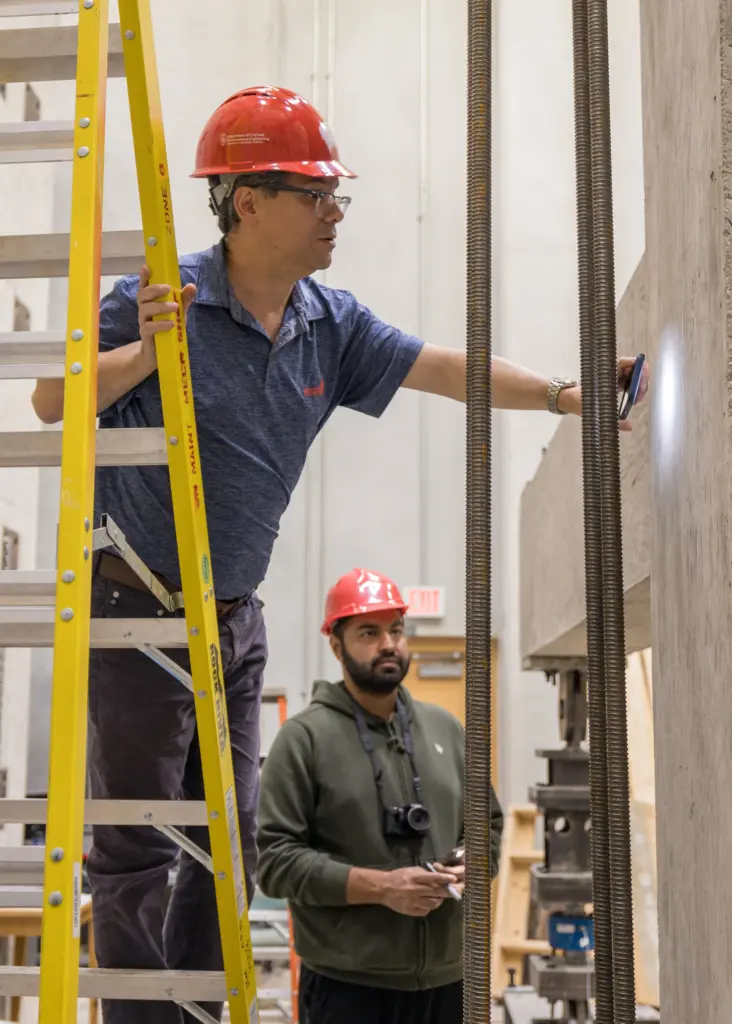One structural engineering professor’s research at the University of Wisconsin-Madison may inform how concrete building codes are set for structures across the country.
Professor Gustavo Parra-Montesinos has conducted a series of large-scale tests to determine how proposed changes to the American Concrete Institute (ACI) 318-19 Building Code Requirements for Structural Concrete (published in 2019) could impact structural integrity. The ACI Code is the guiding document used for the design of concrete building structures in the United States and many other countries around the world.
The changes revolve around required embedment lengths for headed rebar into concrete joints between beams and columns. Hooked bars that extend into a joint with a bend at the end for anchorage are typically used in beam-column joints. However, there are cases in which the hook is replaced by a rounded cap, which are known as headed bars. ACI building code committee members are reviewing proposed changes for the 2025 edition of Building Code Requirements for Structural Concrete, which may reduce how far headed reinforcing bars in beams have to be embedded into a building’s exterior column.
 Professor Gustavo Parra-Montesinos looks at where a test column joins a beam during an experiment in the Jun and Sandy Lee Wisconsin Structures and Materials Testing Laboratory. Parra-Montesinos conducted the tests to study proposed code changes to headed rebar insertion depths where concrete columns and beams intersect. Credit: Alex Holloway.
Professor Gustavo Parra-Montesinos looks at where a test column joins a beam during an experiment in the Jun and Sandy Lee Wisconsin Structures and Materials Testing Laboratory. Parra-Montesinos conducted the tests to study proposed code changes to headed rebar insertion depths where concrete columns and beams intersect. Credit: Alex Holloway.
“There is a proposal to decrease the embedment length from 2019,” Parra-Montesinos says. “There are also new provisions proposed to check the potential for breakout failure in concrete connections. However, as proposed, exterior beam-column connections would be exempted from this check. The potential for breakout failure in these connections, particularly those not designed to withstand earthquakes which often require little confinement reinforcement, is what prompted me to do these tests.”
Parra-Montesinos is a member of several ACI committees, including the prestigious Building Code Committee 318. He has been one of the leading members of this committee since 2014, as a member of its steering committee and as chair of the building code sub-committee on joints and connections.
When a concrete floor is loaded, the headed bars embedded into the column will try to rip out a chunk of adjoining concrete, leading to what’s called a breakout failure. Parra-Montesinos says that code-compliant connections with hooked bars, which have been used for decades, have a long track record of adequate performance without breakout failures. While headed bars have also proven effective, there’s less history behind them.
Parra-Montesinos conducted two tests in the Jun and Sandy Lee Wisconsin Structures and Materials Testing Laboratory at UW-Madison. The first test followed the 2019 code’s requirements, with 1-inch diameter headed bars inserted 18 inches into the column. For the second test, his team inserted the bars 14 inches into the column, which is slightly deeper than proposed for the 2025 code update.
“The structure in the first test performed well, although the amount of damage at the end of the test was concerning,” he says. “For the second test, we did have a breakout failure at the end. We saw even more damage in the joint of the second specimen prior to failure. Some of it was related to a breakout failure mechanism, but there was, to be honest, a lot more damage in the joint than I expected given that the joint design complied with current code provisions.”
To set up the experiment, Parra-Montesinos and his students built a 12-foot-tall column joined to a 10-foot-long beam with infrared sensors arrayed across the front surface and numerous strain gauges attached to the surface of the rebar. They first put the column under 150,000 pounds of compressive force to simulate the load of being part of a larger structure and then used a hydraulic actuator capable of applying up to 230,000 pounds of force to load the structural assembly up to failure.
As the test progressed, the connection between the beam and the column suffered extensive cracking damage. The damage was particularly pronounced in the second concrete structure with shorter embedment depths for its headed bars.
The fact that a code-compliant joint suffered extensive damage is something that Parra-Montesinos says should prompt further testing to evaluate potential design provision changes. He says similar tests should be conducted to determine if joints with hooked bars suffer the same types of damage.
The ACI Foundation supported Parra-Montesinos’ work with funding for a fast-track testing program; the experiments came together over about five months — an impressive accomplishment, given their scale and complexity. Based on the questions raised by the results from these tests, Parra-Montesinos says he hopes to secure additional funding for further testing and evaluation of exterior beam-column connections with headed and hooked bars.
The tests are both a demonstration of the capabilities of the new Jun and Sandy Lee Wisconsin Structures and Materials Testing Laboratory and an invaluable hands-on experience for Parra-Montesinos’ students.
“They’ve been involved in the whole process in terms of going from theoretical aspects to actual design and construction,” he says. “They’ve also gotten the experience to see how a structure behaves at various load intensities, from no damage to failure. That’s not something you want to experience for yourself in the field, so it’s really good that our students can experience this firsthand in a safe environment.”
Featured image caption: A civil and environmental engineering student checks a concrete specimen for cracks during testing in the Jun and Sandy Lee Wisconsin Structures and Materials Testing Laboratory. Credit: Alex Holloway.